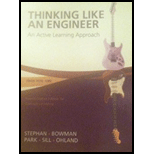
Complete the table by using the equation of weight.
Explanation of Solution
Given data:
| Pound-mass | kilogram | newton | Pound-force | |
| Abbreviation | kg | |||
| Example | 0.33 | 0.15 | 1.47 | 0.33 |
| (a) | 10 | |||
| (b) | 700 |
Calculation:
The pound can be used as a unit of force or mass. To distinguish mass in terms of pounds and force in terms of pounds, the units of mass in terms of pounds is pound-mass which is abbreviated as
Similarly, the units of force in terms of pounds is pound-force which is abbreviated as
The SI unit of force is Newtons, which is denoted as N.
Case (a):
Consider the conversion factor from kilogram to pound-mass.
Rearrange the conversion as follows.
Convert
Substitute
Since the object is on earth, therefore acceleration due to gravity
Consider the expression for force
Here,
Substitute
Consider the conversion factor from Newtons to pound-force.
Convert
Substitute
Case (b):
Convert
Substitute
Rearrange equation (1) to obtain the mass in terms of kilograms.
Substitute 700 N for F and
Convert
Substitute
Complete the table by using the calculated values as shown in Table 1.
Table 1
| Pound-mass | kilogram | newton | Pound-force | |
| Abbreviation | kg | N | ||
| Example | 0.33 | 0.15 | 1.47 | 0.33 |
| (a) | 10 | 4.535 | 44.5 | 10 |
| (b) | 157.5 | 71.42 | 700 | 157.5 |
Conclusion:
Thus, the unknown parameters in the table are calculated.
Want to see more full solutions like this?
Chapter 8 Solutions
Thinking Like an Engineer
- my ID# 016948724. Please solve this problem step by steparrow_forwardMy ID# 016948724 please find the forces for Fx=0: fy=0: fz=0: please help me to solve this problem step by steparrow_forwardMy ID# 016948724 please solve the proble step by step find the forces fx=o: fy=0; fz=0; and find shear moment and the bending moment diagran please draw the diagram for the shear and bending momentarrow_forward
- My ID#016948724 please solve this problems and show me every step clear to follow pleasearrow_forwardMy ID# 016948724arrow_forwardPlease do not use any AI tools to solve this question. I need a fully manual, step-by-step solution with clear explanations, as if it were done by a human tutor. No AI-generated responses, please.arrow_forward
- Please do not use any AI tools to solve this question. I need a fully manual, step-by-step solution with clear explanations, as if it were done by a human tutor. No AI-generated responses, please.arrow_forwardPlease do not use any AI tools to solve this question. I need a fully manual, step-by-step solution with clear explanations, as if it were done by a human tutor. No AI-generated responses, please.arrow_forward[Q2]: The cost information supplied by the cost accountant is as follows:Sales 20,00 units, $ 10 per unitCalculate the (a/ newsale guantity and (b) new selling price to earn the sameVariable cost $ 6 per unit, Fixed Cost $ 30,000, Profit $ 50,000profit ifi) Variable cost increases by $ 2 per unitil) Fixed cost increase by $ 10,000Ili) Variable cost increase by $ 1 per unit and fixed cost reduces by $ 10,000arrow_forward
 Elements Of ElectromagneticsMechanical EngineeringISBN:9780190698614Author:Sadiku, Matthew N. O.Publisher:Oxford University Press
Elements Of ElectromagneticsMechanical EngineeringISBN:9780190698614Author:Sadiku, Matthew N. O.Publisher:Oxford University Press Mechanics of Materials (10th Edition)Mechanical EngineeringISBN:9780134319650Author:Russell C. HibbelerPublisher:PEARSON
Mechanics of Materials (10th Edition)Mechanical EngineeringISBN:9780134319650Author:Russell C. HibbelerPublisher:PEARSON Thermodynamics: An Engineering ApproachMechanical EngineeringISBN:9781259822674Author:Yunus A. Cengel Dr., Michael A. BolesPublisher:McGraw-Hill Education
Thermodynamics: An Engineering ApproachMechanical EngineeringISBN:9781259822674Author:Yunus A. Cengel Dr., Michael A. BolesPublisher:McGraw-Hill Education Control Systems EngineeringMechanical EngineeringISBN:9781118170519Author:Norman S. NisePublisher:WILEY
Control Systems EngineeringMechanical EngineeringISBN:9781118170519Author:Norman S. NisePublisher:WILEY Mechanics of Materials (MindTap Course List)Mechanical EngineeringISBN:9781337093347Author:Barry J. Goodno, James M. GerePublisher:Cengage Learning
Mechanics of Materials (MindTap Course List)Mechanical EngineeringISBN:9781337093347Author:Barry J. Goodno, James M. GerePublisher:Cengage Learning Engineering Mechanics: StaticsMechanical EngineeringISBN:9781118807330Author:James L. Meriam, L. G. Kraige, J. N. BoltonPublisher:WILEY
Engineering Mechanics: StaticsMechanical EngineeringISBN:9781118807330Author:James L. Meriam, L. G. Kraige, J. N. BoltonPublisher:WILEY





